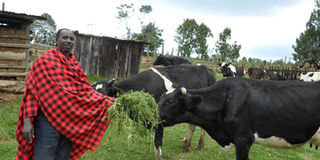I sold 200 animals to buy 3 dairy cows

Mr Simion ole Poror in his farm in Narok.
JOSPHAT NGENO | NATION
What you need to know:
- “Each cow produces an average of 40 litres a day, which I sell at Sh60 a litre,” he tells Seeds of Gold as he goes through his well-kept records. The cows he sold used to produce two litres of milk a day.
- The farmer, 65, blames the sentimental attachment many farmers in the region have for the traditional animals as the reason they have not reaped from livestock farming.
- But keeping dairy animals is not an easy ride since the feed is quite expensive. “I have planted plenty of napier grass and lucerne but cows cannot feed on that only. I have to add wheat and barley straws, which I buy from neighbouring farms.”
When Simion ole Poror told his family and relatives in 2001 that he was going to sell his 200 cows and goats to buy three exotic dairy cows, many of them thought he was out of his senses.
They convened an urgent meeting to discuss his unprecedented decision. “They even threatened to curse me,” recounts the farmer.
But he stood his ground. His quest to venture into dairy farming was irresistible.
“I had made up my mind to venture into dairy farming after learning from several farmers’ field days I had attended that it was a rewarding venture,” he tells Seeds of Gold in his farm in Enaibelbel, Narok.
Having defied his kinsmen, the farmer went ahead and sold his cows and goats. “I got Sh760,000 from the animals. I used Sh150,000 to buy three Friesian cows from a farmer in Nakuru.”
He used what he was left with to dig a borehole, build cow sheds and plant fodder. The three cows have since multiplied to over 30.
“Then, I was only armed with confidence. I was lucky that the farmer was reducing his herd as he had been hit hard by drought,” says Poror, who is the chairman of Narok Dairy Farmers Association.
His dairy farm is now valued at Sh10 million, with the market for milk in Narok expanding.
“Each cow produces an average of 40 litres a day, which I sell at Sh60 a litre,” he tells Seeds of Gold as he goes through his well-kept records. The cows he sold used to produce two litres of milk a day.
Poror usually looks back with satisfaction, saying that he is happy he did not stick with the traditional animals.
“It takes a bold heart to discard what one has believed in for years. I see my friends still keeping their traditional animals under the free range system yet they are not getting much.”
The farmer, 65, blames the sentimental attachment many farmers in the region have for the traditional animals as the reason they have not reaped from livestock farming.
“It is hard to continue keeping such large numbers of animals as the land is becoming smaller and drought has become common.”
Never had Poror imagined that one day he would become the biggest dairy farmer in the county where pastoralism thrives. “I visit Egerton University frequently for farming lessons and never miss farmers’ field days, it is where I meet experts who I ask questions about my animals.”
Poror’s farm showcases what fortunes dairy farming can bring. It has been recognised for modern farming practices.
Early this year, the County Government of Narok sponsored him for a trip to Israel to widen his dairy farming knowledge. His farm has been drawing visitors in big numbers as it stands like an oasis in a desert.
In the farm, everything, from the cow sheds to pasture is well-organised. A cowshed with pedigree animals welcomes one into the farm. The cows can be seen munching napier grass mixed with desmodium.
Opposite the shed is a feed store filled with hay, silage and napier grass. Near the store are two 87 and 100-foot newly drilled boreholes.
The napier grass occupies three acres of the farm. The farmer also plants lucerne. Poror engages experts in all his steps.
“Livestock experts have become my best friends. They have been by my side in all my undertakings, from designing the farm layout,” the retired teacher says.
Poror learned how to make silage and has passed the knowledge to his workers. They mix napier grass, molasses and other food products to make the feed.
“Napier grass is shredded into smaller pieces, then packed into polythene bags to ferment. This only takes three days.”
EXPENSIVE FEED
But keeping dairy animals is not an easy ride since the feed is quite expensive. “I have planted plenty of napier grass and lucerne but cows cannot feed on that only. I have to add wheat and barley straws, which I buy from neighbouring farms.”
Getting the right staff to take care of the animals is also not easy.
“Most of those I get for hiring do not have any knowledge in farming. I have to train them lest they mess up things,” says the farmer, who intends to hire a farm manager for better yields and has encouraged over 100 farmers in Narok, a mostly pastoralist county, to embrace commercial dairy farming.
To maximise his earnings, Poror has set up a milk selling business in Narok town.
Narok County Agriculture Executive Richard Birir says they aim to transform the region into a dairy hub. The county has rolled out subsidised artificial insemination services.
“We have already set aside money to help farmers get quality breeds. We are also launching field days to ensure that we sensitise the community on the importance of agribusiness and value addition.”
He adds the county government is constructing milk cooling plants worth Sh3.7 million this year.
“Gone are the days when cattle were kept for sentimental reasons. Farmers must do the math and see what they get in the long run.”




